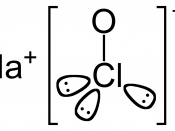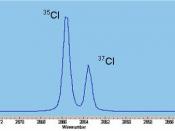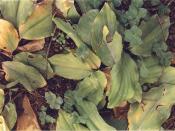PurposeIn this experiment, sodium hypochlorite (NaOCl) in acetic acid mixture was used to oxidize emdo-borneol (an alcohol) to camphor (a ketone). The product would then be purified by sublimation and then be analyzed by Infrared spectroscopy and melting point test.
Procedure and ObservationsPlease refer to the lab manual and the carbon copy attached.
Data and CalculationsWeight of endo-borneol = 0.2013gNo of moles of endo-borneol = 0.2013g/154.25g mol-1 = 1. 305mmolSince one mole of endo-borneol should give one mole of camphorTheoretical yield of camphor = (1.305 mmol )( 152.23g mol-1) = 0. 1987gTheoretical melting point of camphor = 179.75 oCActual Yield of the product (camphor) = 9. 5360 - 9. 4873 = 0. 0487 g% Yield of the product = (100)* Actual yield/ Theoretical yield= (100)* 0.0487g/0.1987g =24.5%Melting point of product tested = 136oCConclusions and Answers to QuestionsIn this experiment, aqueous sodium hypochlorite (NaOCl), or common household bleach was used as oxidizing agent and it was generally made from chlorine reacting with sodium hydroxide:Acetic acid, which acted as a solvent, was then added into the NaOCl to generate hypochlorous acid (HOCl) via acid base reaction:Since OH- was a bad leaving group, HOCl was not likely to be ionized to produce positive chlorine species.
The possible source of positively charged chlorine (Cl+) was likely to be from heterolytic bond cleavage of chlorine:In the first step of reaction mechanism of hypochlorite oxidation of endo-borneol to camphor, a hydroxyl proton was replaced by the positive chlorine. In the second step, HCl was eliminated via E2 elimination from the alkyl hypochlorite to form ketone. In the first step, Cl+ was added to the alcohol but in the following step Cl- was lost. The net change was a reduction of two electrons and the endo-borneol that provided the electrons was therefore oxidized.


